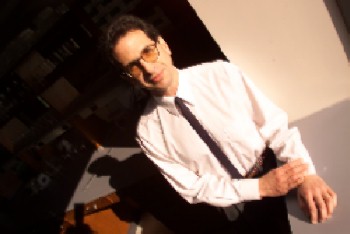
Walter Chazin, Ph.D., directs the new Vanderbilt Structural Biology Program. (photo by Dana Johnson)
Conference to probe latest magnetic therapy advances
Leading scientists and physicians from across the nation will gather at Vanderbilt University Medical Center this weekend to dissect and explore one of health care's hottest topics — the use of magnets and magnetic devices to treat chronic pain and other ailments.
The popularity of these devices is increasing, which raises the need for health professionals to establish a rational basis for their use. Until now, most scientific discussion of magnet devices has been restricted to basic research topics or theoretical evidence rather than clinical applications.
In an attempt to change that, the Vanderbilt Neuromagnetics Institute and the Bioelectromagnetics Society are sponsoring "Potential Therapeutic Applications of Magnetic Fields."
The two-day symposium — the first of what organizers hope will be a continuing series — will be held Monday and Tuesday, Nov. 15 and 16, at Light Hall. Through numerous seminars and presentations by some of the world's leaders in magnetic research, the symposium will present a balanced scientific forum for both basic investigators and clinical researchers by providing the latest information on the therapeutic use of magnetic fields.
"There are a lot of people using magnetic devices for a variety of conditions, and most are using them without any medical direction," said Dr. Michael J. McLean, associate professor of Neurology and program chair for the symposium.
"More than $1 billion worth of magnets are sold annually, so the interest is high in the general public as well as in the scientific community. This will be a state-of-the-art presentation what is known today, clinically and in the laboratory, and what is reasonable to expect now and in the future."
The symposium is aimed at health professionals interested in the fields of neuromagnetics, magnetic field principles, and therapeutic interventions with magnetic devices. The information presented will give new insights to those health professionals on the front lines, the physicians, nurses, physical rehabilitation workers and chiropractors who treat and provide guidance to the general public.
This first symposium has three primary objectives: establishing an ongoing forum for advancing quality research into the clinical application of magnetic fields; developing further insights into magnetic fields' mechanisms of action as well as global research efforts to date; and creating a high level of scientific awareness regarding the breadth of biological and physical investigations involving magnetic field explorations.
Individual presentations will be made by 16 speakers at the two-day "Potential Therapeutic Applications of Magnetic Fields" symposium. They will include:
• "Molecular Targets for Biological Effects of Magnetic Fields," by Dr. Ross Adey, University of California, Riverside;
• "Static Magnetic Field Treatment of Bi-Polar Disorders," by Dr. Robert Post, National Institutes of Health;
• "Treatment of Painful Diabetic Neuropathy with Static Magnetic Fields," Dr. Michael Weintraub, New York Medical College;
• "The Design of Studies to Treat Pain with Static Magnetic Fields," Dr. Robert Holcomb, assistant professor of Neurology, VUMC.
For more information on the symposium, review the program on the Department of Neurology website (www.mc.vanderbilt.edu/neurology; then select CME and Magnets).
Downloadable registration forms are available and registration on-site will also be available.













